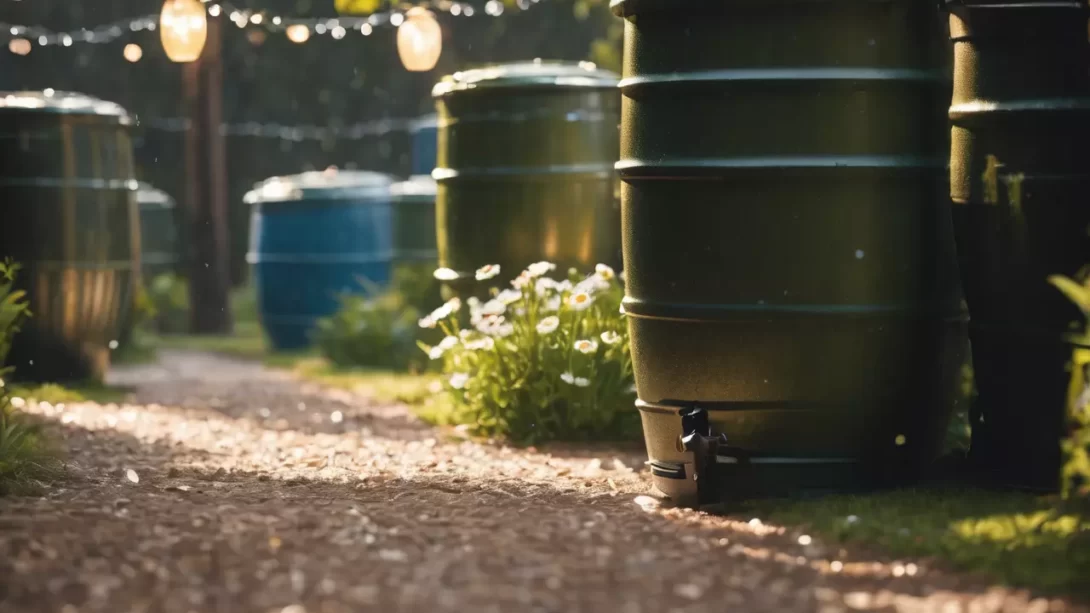Daisy chaining rain barrels is an effective method for maximizing rainwater collection and storage in your garden. This technique involves connecting multiple barrels together so that when one fills up, the overflow goes into the next barrel. It’s an efficient way to ensure you have a larger supply of rainwater for gardening needs, especially in areas with inconsistent rainfall. Besides being environmentally friendly, it can also reduce water bills and decrease the demand on municipal water supplies.
Assessing Your Needs and Planning
Before you start, assess how much water you’ll need for your garden. This depends on the size of your garden, the types of plants you’re growing, and the typical rainfall patterns in your area. Once you have an estimate, plan the number and placement of barrels. Ideally, barrels should be placed near downspouts for easy collection of rainwater from your roof. Consider the space around your home and how the barrels will fit into the landscape. It’s important to ensure that the area where you plan to place the barrels is level and stable.
Choosing the Right Rain Barrels
Selecting the right barrels is crucial for a successful daisy chain setup. Look for barrels that are sturdy, durable, and made of materials suitable for long-term outdoor use. The size of the barrels will depend on your water needs and the available space. It’s also important to choose barrels that can easily be linked together. Some rain barrels come with built-in connectors for daisy chaining, while others may require additional fittings. Ensure that all barrels have compatible connectors for a seamless and efficient setup.
Preparing for Installation
Before installing your rain barrels, gather all the necessary tools and materials. You will need a drill, watertight connectors or hoses, a saw for cutting downspouts, and possibly additional tools depending on your specific setup. Also, gather any additional fittings or adapters needed to connect the barrels together.
Preparing the installation site is critical for the proper functioning of your daisy chain system. Choose a location near a downspout for easy water collection. Ensure the ground is level and stable to support the full weight of the barrels when filled with water. If necessary, create a firm base using pavers or a concrete pad. This not only provides stability but also helps prevent any potential water damage to your property.
Connecting the Rain Barrels
The process of connecting the barrels begins by positioning them correctly near the downspouts. If the barrels are not equipped with a pre-made linking system, you may need to drill holes near the top (for the overflow) and at the bottom (for the hose connecting to the next barrel) of each barrel.
- Connecting the Downspout: Modify the downspout so it directs water into the first barrel. This may involve cutting the downspout and attaching a diverter or a flexible downspout hose.
- Linking Barrels Together: Use hoses or pipes to connect the overflow valve of one barrel to the intake of the next. Ensure that these connections are secure and leak-proof. You can use watertight sealant or rubber gaskets to prevent leaks.
- Ensuring Proper Flow: Check that the barrels are aligned so that water can flow freely from one to the next. The overflow hole should be positioned slightly below the top of the barrel to prevent water from spilling before it flows into the next barrel.
Overflow Management and Maintenance
Managing overflow is an important aspect of a daisy-chained rain barrel system. An effective overflow system ensures that excess water is directed away from the foundation of your home, preventing potential water damage. Connect an overflow hose to the last barrel in your chain and direct it to a safe area, such as a garden bed or a storm drain. This setup also helps in managing water during heavy rains when the barrels quickly fill up.
Regular maintenance of your rain barrels is crucial for their longevity and efficiency. Inspect your barrels periodically for leaks, cracks, or algae growth. Keep the gutters and downspouts clear of debris to ensure optimal water flow into the barrels. During winter, if you live in a region with freezing temperatures, it’s advisable to empty the barrels to prevent damage from expanding ice.
Incorporating into Your Watering System
Integrating your daisy-chained rain barrels into your existing watering system can make garden irrigation more efficient and eco-friendly. You can use a simple gravity-fed system for watering nearby plants or install a pump to distribute water to more distant areas of your garden. Ensure that your barrels are elevated higher than the area you intend to water to maximize the effectiveness of a gravity-fed system.
For more sophisticated setups, consider installing a soaker hose or drip irrigation system connected to your rain barrels. This allows for slow, steady, and deep watering, which is beneficial for plant growth and saves time and effort.
Conclusion
Daisy chaining rain barrels is a practical and environmentally friendly way to collect and utilize rainwater in your garden. By following these steps to properly plan, install, and maintain your system, you can enjoy an efficient and sustainable watering solution. Not only does this method help in conserving water, but it also reduces reliance on municipal water supplies and can lower water bills. Embrace this green initiative in your garden to contribute positively to water conservation efforts.



